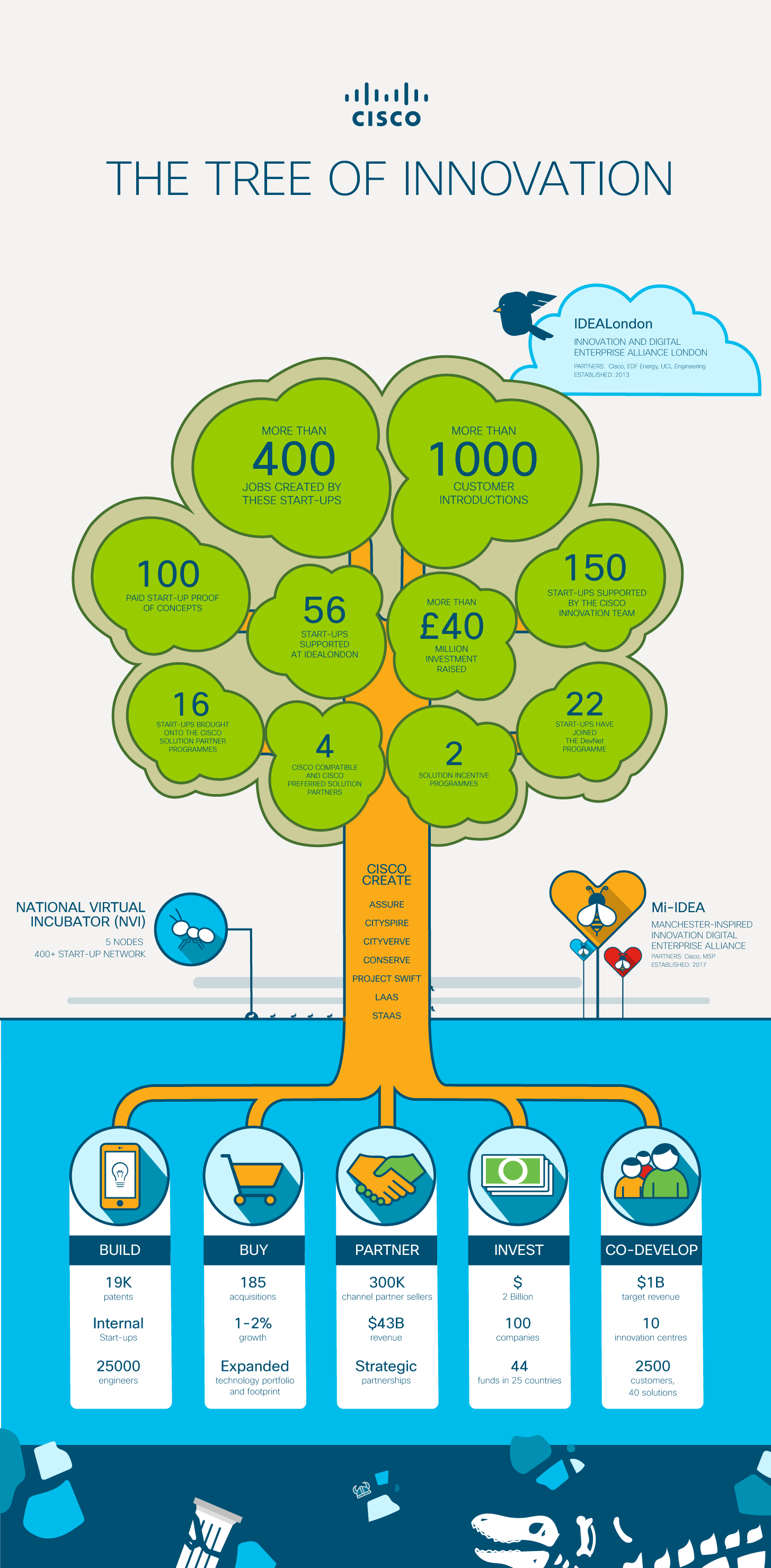
Success depends upon collaboration.
It’s integral to human survival – Charles Darwin actually wrote more about collaboration than competition when he first set out his theory of natural selection.
And it’s also integral to start-up survival.
At Cisco, we know this – which is why our start-up ecosystem is not just surviving, but thriving.
With the recent opening of Mi-IDEA, we’ve added another post-accelerator centre to our UK co-innovation ecosystem, which already includes IDEALondon, CREATE, and the NVI (National Virtual Incubator) Network.
Expanding our ecosystem is good for everyone. It means we’re going to continue collaborating, working off each other, and growing in symbiosis long into the future.
But before we celebrate our achievements so far, let’s think about what a start-up ecosystem entails.
We use the term a lot: but what does it actually mean?

Introducing the co-innovation ecosystem
Our entire approach towards co-innovation can actually be thought of as an ecosystem.
In the spirit of Darwin, let’s take an example from the natural world.
Think of a tree: it’s both a living organism and a habitat for other living things. In this way it acts as the centre of an ecosystem.
The tree is supported by roots, which in our ecosystem are represented by our five global pillars of innovation.
Then we have the mid-section. For a tree this is the trunk; in our case, it’s the projects that act as the test centres for new innovations, like our smart city demonstrator, CityVerve, and Cisco CREATE.
The branches and leaves host the actual inhabitants of the ecosystem – the flora and fauna, if you like: Mi-IDEA, IDEALondon, and the NVI.
In this sense the whole UKI innovation story is connected; each entity relies on the other.
Roots: the foundation for co-innovation
Our tree of innovation has five roots: build, buy, partner, invest, and co-develop. They are Cisco’s pillars of innovation:
- Build: Working within Cisco, with the developer community, or with customers, to build new technologies
- Buy: Acquiring new technologies
- Partner: Strategically partnering to further build out the business
- Invest: Exploring and seeding investment in specific areas where technology is in its infancy or no dominant technology exists. We have an investment portfolio of £2 billion, with more than 100 direct investments around the world
- Co-develop: Developing new solutions with multi-party teams that include customers, channel partners, start-ups, independent software vendors, and academics
It’s important that the very base of the tree is something strong that is also capable of infusing the rest of the ecosystem with a creative and innovative spirit. The tree of innovation depends on its roots – just like a tree in the natural world.
Trunk: transmitting ideas and encouraging fully-formed organizations
Moving up through the tree, the trunk supports new innovation from below and conducts the spirit of innovation upwards from the roots.
A good example of an organisation that sits in this part of the ecosystem is Cisco CREATE (which stands for Collaborative Research and Emerging Technologies).
It’s a place where concepts become proofs – meaning that it links together new start-ups and emerging ideas with those that are fully formed.
CityVerve, our smart city demonstrator based in Manchester, is also a project which holds a place in the mid-section of the ecosystem.
As a demonstrator, it performs a supportive function, just like a physical tree trunk, whilst also bringing new ideas to the top – just as a trunk brings up nutrients.
Flora and fauna: citizens of the start-up ecosystem
Finally, the tree itself is home to other creatures: our post-accelerators, and the NVI.
The post-accelerators are a place where start-ups can flourish and scale.
As of very recently, we have two in the UK: IDEALondon, and Mi-IDEA in Manchester.
One of the best things about the post-accelerators is the fact that there are so many stakeholders involved.
Mi-IDEA, for instance, is run in collaboration with Manchester Science Partnerships, while IDEALondon is run alongside University College London and EDF Energy.
This means that they are tapped into a greater ecosystem beyond the Cisco innovation tree.
They can present and receive inspiration from the start-up communities in London and Manchester – an example of a wider, more exciting form of collaboration.
It’s a similar situation with the NVI, a government-supported initiative created to encourage wider collaboration between entrepreneurs and technology start-ups, which connects existing innovation centres and start-up founders around the UK.
These organisations are the products of the ecosystem as much as they are part of it.
They go out into the world and interact with other businesses on their own terms, but essentially live within, contribute to, and are supported by the Cisco innovation ecosystem.
Build a whole ecosystem to find success
If necessity is the mother of invention, then interaction is the mother of innovation.
You have to be able to interact with other organisations around you in order to keep learning and find success. This is true of business, just as it is true in nature.
You need to share an environment (which, for the start-ups in our post-accelerators in Manchester and London, is a physical reality) in order to exchange ideas, vision and energy.
We’ve seen huge success with this approach so far, as the new addition of a second post-accelerator proves.
And so, as we continue to collaborate, we can look forward to continued success.
4 Comments
Good read Tom – and it’s fantastic to have been part of this ecosystem (IDEALondon in our case). And still be very much part of the extended family three years later. The support you provide to startups like us (EnergyDeck / Fabric Alpha – remind me to update you on the latest) with these initiatives is really outstanding. Better than any accelerator! ;).
Thanks Ben – love to hear more about that !
http://www.fabricalpha.com – now you made me do it, but thanks for the prompt! 🙂
Excellent blog, Tom. Very insightful.